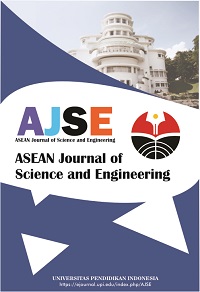Bioactive Compounds and Antioxidant Activity of Ethanol Leaf Extract of Eucalyptus Tereticornis
Abstract
Keywords
Full Text:
PDFReferences
Abbasi, M.A., Saleem, H., Aziz-ur, R., Riaz, T. and Ajai, M. (2013). Determination of antioxidant activity and phyto-constituent screening of Euphorbia heterophylla Linn. British Journal of Pharmaceutical Research, 3(2), 202-216.
Ajila, C.M., Naidu, K.A., Bhat, S.G. and Prasada Rao, U.J.S. (2007). Bioactive compounds and antioxidant potential of mango peel extract. Food Chemistry, 105, 982–988.
Ali, S.S., Kasoju, N., Luthra, A. and Singh, H. (2008). Indian medicinal herbs as sources of antioxidants. Food Research International, 41(1), 1-15.
Ani, O.N., Ani, O., Asogwa, K. K., Onyishi, C. K., Ujah, I. I. and Ebulue, M.M. (2020). Nutritional profile, bioactive compound content and antioxidant activity of ethanol leaf extract of Eucalyptus tereticornis. European Journal of Biomedical and Pharmaceutical Sciences, 7(5), 61 – 73.
Barros, L., Baptista, P., Correia, D.M., Morais, J.S. and Ferreira, I.C.F.R. (2007). Effects of conservation treatment and cooking on the chemical composition and antioxidant activity of Portuguese wild edible mushrooms. Journal of Agricultural and Food Chemistry, 55, 4781-4788.
Chauhan, K., Sharma, S., Agarwal, N. and Chauhan, B. (2011). Lycopene of tomato fame: its role in health and disease. International Journal of Pharmaceutical Sciences and Research, 10, 99–115.
DiMascio, P., Kaiser, S. and Sies, H. (1989). Lycopene as the most effective biological carotenoid singlet oxygen quencher. Archives of Biochemistry and Biophysics, 274, 532-8.
Duh, P.D., Tu, Y.Y. and Yen, G.C. (1999). Antioxidant activity of the aqueous extract of harn jyur (Chrysanthemum morifolium Ramat). Lebensmittel-Wissenschaft and Technologie, 32, 269-277.
Garcia, M.D., Fernandez. M.A., Alvarez, A. and Saenz, M.T. (2004). Antinociceptive and anti-inflammatory effect of the aqueous extract from leaves of Pimentaracemosavar. ozua (Myrtaceae). Journal of Ethnopharmacology, 91(1), 69-73.
Kubow. S. (1992). Routes of formation of toxic consequences of lipid oxidation products in foods. Free Radical Biological Medicines, 12, 63–81.
Niki, E., Shimaski, H. and Mino, M. (1994). Antioxidantism-studies on products of browning reaction: antioxidative activity of products of browning reaction. Japan Journal of Nutrition, 40, 307–315.
Ohkawa, H., Ohishi, N. and Yagi, K. (1978). Assay for lipid peroxides in animal tissues by thiobarbituric acid reaction. Analytical Biochemistry, 95, 351–358.
Okwu, D.E. and Ekeke, O. (2003). Phytochemical screening and mineral composition of chewing sticks in south Eastern Nigeria. Global Journal of Pure and Applied Science, 9, 235-238.
Rozina, P., Sukalayan, K.K. and Pijush, S. (2013). In Vitro nitric oxide scavenging activity of methanol extracts of three Bangladeshi medicinal plants. The Pharma Innovation – Journal, 1(12), 83-88.
Scarfiotti, C.1, Fabris, F., Cestaro, B. and Giuliani, A. (1997). Free radicals, atherosclerosis, ageing, and related dysmetabolic pathologies: pathological and clinical aspects. European Journal of Cancer Prevention, 6(1), S31-6.
Shahidi, F. and Wanasundara, P.K.J.P.D. (1992). Phenolic antioxidants. Critical Reviews in Food Science and Nutrition, 32, 67–103.
Shahraki, A. and Shahraki, M. (2013). Comparison of Eucalyptus aqueous extract and insulin on blood sugar and liver enzymes in diabetic male rats. Zahedan Journal of Research in Medical Sciences, 15, 25-28.
Sharma, S. and Vig, A.P. (2013). Evaluation of in vitro antioxidant properties of methanol and aqueous extracts of Parkinsonia aculeata leaves. The Scientific World Journal, 2013, 1-7.
Singh, H.P., Kaur. S., Negi. K., Kumari, S., Saini, V. and Batish, D.R. (2012). Assessment of in-vitro antioxidant activity of essential oil of Eucalyptus citriodora (lemon-scented Eucalypt; Myrtaceae) and its major constituents. Lebensmittel-Wissenschaft and Technologie, 48(2), 237–241.
Udedi, S.C., Ani, O.N., Anajekwu, B.N., Ononamadu, C.J., Igwilo, I.O., Ibeabuchi, C.G., Ifemeje, J.C., Lukong, C.B. and Ogbuozobe, G.O. (2012) Nutritional composition and antioxidant activity of African Walnut, Tetracarpidium conophorum, The Journal of Applied Biochemistry, 107, 170-180.
DOI: https://doi.org/10.17509/ajse.v3i1.45017
Refbacks
- There are currently no refbacks.
Copyright (c) 2022 Universitas Pendidikan Indonesia

This work is licensed under a Creative Commons Attribution-ShareAlike 4.0 International License.












